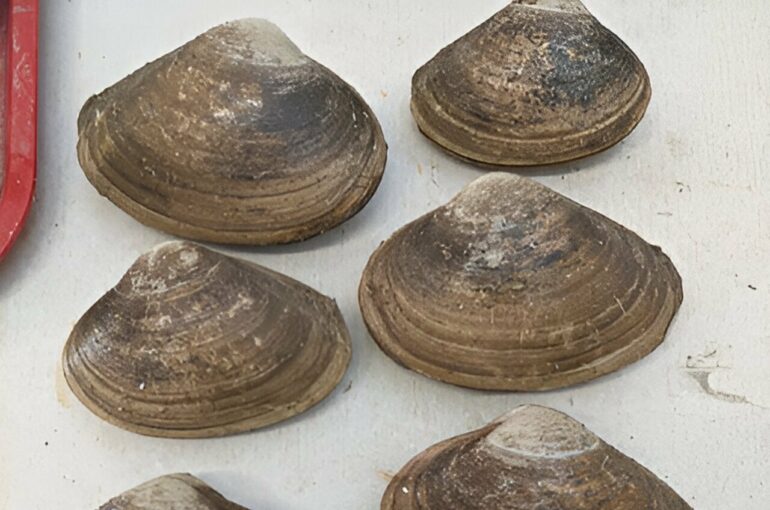The Atlantic surf clam, an economically valuable species that is the main ingredient in clam chowder and fried clam strips, has returned to Virginia waters in a big way, reversing a die-off that started more than two decades ago.
In a comprehensive study of surf clams collected from an area about 45 miles due east from the mouth of the Chesapeake Bay, Rutgers scientists have found the population to be thriving and growing. A likely reason could be that environmental conditions have improved, and another possibility is that the clams have adapted, the scientists said. The report, published in the journal Estuaries and Coasts, details the characteristics of a population of healthy-size surf clams of different ages living just under the surface of the sandy ocean bottom.
It’s all a bit of a surprise.
“It’s unexpected and it’s good news,” said Daphne Munroe, an associate professor in the Department of Marine and Coastal Sciences in the Rutgers School of Environmental and Biological Sciences, and an author of the study. “They disappeared some time ago—we thought they were gone. But we found there were more clams there than we thought we were going to see. And they are flourishing.”
Surf clams started disappearing from waters off the coast of Virginia in the late 1990s, affected by warming water, Munroe said. By the turn of the 21st century, there were too few present to justify fishing in those waters.
One day in 2021, Munroe received a phone call from one of her fishing partners with whom she often collaborates.
“He said, ‘Daphne, do you know I’ve got five boats working out of Cape Charles [off Virginia’s Eastern Shore] right now? They’re catching surf clams and we’re putting them on trucks,'” Munroe said.
She added, “And I said, ‘What is that? What are they doing? How is that possible?'”
The refrigerated trucks carting seafood were headed to Port Norris, N.J., she was told, the location of one of the main surf clam processing plants on the East Coast. Munroe works out of the New Jersey Agricultural Experiment Station’s Haskin Shellfish Research Laboratory in Port Norris, just around the corner from the processor.
“I told him, ‘I have to see those clams. That’s crazy.'”
Munroe, an expert in the dynamics of coastal and marine ecosystems, examined the surf clams and a new research study was born. She hired a Michigan State undergraduate, Brynne Wisner, as an intern. Wisner, who would lead the collection, preparation and measurement of the clams, became first author on the study.
The Atlantic surf clam—its shell well-known to beachcombers in the northeastern U.S.—is one of the most common species of bivalves in the western Atlantic Ocean. Surf clams can live 40 years and grow their shells up to 8 or 9 inches long.
While its habitat ranges from the Gulf of St. Lawrence in Canada to Cape Hatteras in North Carolina, the surf clam’s primary population lives off the coast of New Jersey. There, the relatively shallow Northeast U.S. Continental Shelf provides an ideal, vast breeding habitat, extending for about 100 miles before a falloff to the canyons of the deep ocean. The animals also thrive in the Cold Pool, a band of cold near-bottom water that streams through the lower regions of this section of the New York-New Jersey Bight.
The researchers used the New Jersey surf clam population, perfectly located in the middle of the species range, as a standard of comparison in the study. From the samples collected from Virginia waters, scientists recorded the ages of each surf clam shell (as with trees, the successive rings on the shells equate to years lived), its size, rate of growth and whether the surf clam contained a generous portion of meat. They also collected tissue samples for genetic analysis.
“The clams in the southern range are in good shape,” Munroe said. “They are still young, and growing as we would expect.”
The study found multiple generations of surf clams in the animals collected, a sign of a healthy, expanding population.
“The finding suggests that environmental conditions may have improved for surf clams in the south, or that this population has acclimated to altered conditions,” Munroe said.
Understanding the population of surf clams at the southern edge of their range can help researchers better understand shifts in the ranges of species and possible adaptation and recovery, Munroe said.
The genetic analysis indicated that among the population of the surf clam species Spisula solidissima solidissima, a smaller subspecies better known for favoring warmer climates, Spisula solidissima similis, was also found living there.
Further research, Munroe said, will investigate the possibility of mating between these species. This phenomenon, known as subspecies hybridization, can be an important path for species to adapt to a changing environment.
In addition to Munroe and Wisner, other Rutgers scientists on the study included Ximing Guo, a distinguished professor in the Department of Marine and Coastal Sciences; Zhenwei Wang, a doctoral student; and Ailey Sheehan, a lab technician, all with the Haskin Shellfish Research Laboratory.
More information:
Brynne Wisner et al, Genetics, Age Demographics, and Shell Size of Atlantic Surfclams from the Southern Edge of Their Range, Estuaries and Coasts (2023). DOI: 10.1007/s12237-023-01281-z
Provided by
Rutgers University
Citation:
Surf clams off the coast of Virginia reappear and rebound (2024, April 16)
